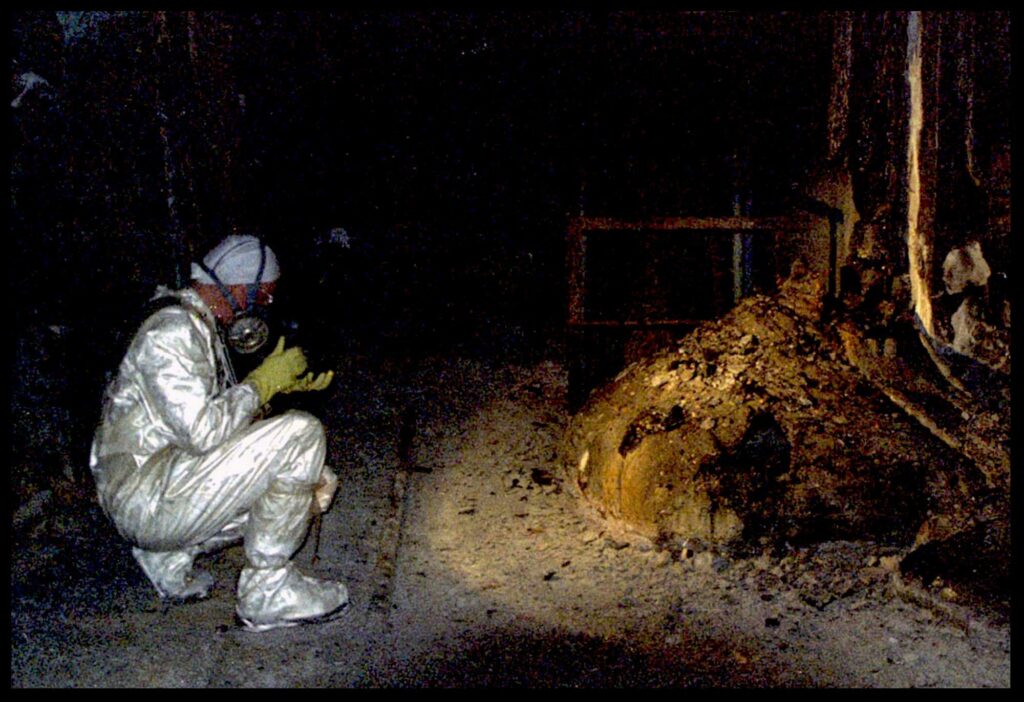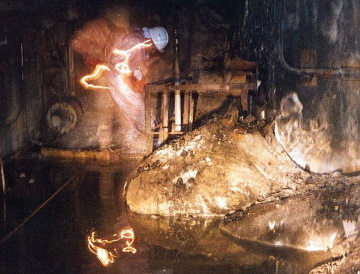Last updated on October 18th, 2023 at 10:59 pm
On April 26, 1986, a devastating nuclear accident occurred at the Chernobyl Power Plant in Ukraine.
The accident was so powerful that it caused an explosion that shattered reactor number four and released more radioactive material than the atomic bombs dropped on Hiroshima and Nagasaki combined. This radioactive material spread across Belarus, Ukraine, and parts of Europe.
The explosion itself created what is now known as “The Elephant’s Foot” – a mass of melted nuclear fuel located deep within the Chernobyl site.

What is the Elephant’s foot of Chernobyl?
The “Elephant’s Foot” is a massive, highly radioactive mixture of corium and other materials that formed underneath the Chernobyl Nuclear Power Plant following the April 1986 nuclear explosion.
The Elephant’s Foot was formed when the molten core of the reactor came in contact with the cool water in the basement of the reactor building. This caused the reactor’s fuel rods to shatter and release their nuclear fuel, which mixed with the water and concrete of the floor to form the Elephant’s Foot.
How it got its name is far less interesting. It’s called the Elphant’s Foot because it looks like an elephant’s foot.
It is known for its intense radiation level and is estimated to be around 500 times more radioactive than the lethal limit for human exposure. The radiation from the Elephant’s Foot is so intense that it can kill a person within a few minutes of exposure.
However, our exploration and knowledge of the Elephant’s foot of Chernobyl would be incomplete without a sneak peek into the underlying cause of the disaster.

What Caused the Chernobyl Disaster?
History shows that the disaster at the Chernobyl power plant blended human and mechanical factors. It was a combination of human error and a flawed reactor design.
Here is precisely how the explosion happened:
On the evening of April 25, 1986, plant workers were conducting a test on the emergency shutdown system. However, they did not prepare for the test correctly and disabled some safety systems. As a result, when they tried to shut down the reactor, it exploded, sending radioactive material into the air.
The explosion blew the roof off the reactor building and caused fires to break out in the reactor and other nearby buildings.
The fire department came to the scene, but they were not sufficiently equipped to handle a nuclear emergency and made things worse by spreading the contamination. As a result, the explosion and fire released around 5% of the reactor’s nuclear fuel, which burned and spewed radioactive particles everywhere.
Essentially, about 50 emergency workers lost their lives to acute radiation syndrome, including nine children who were victims of thyroid cancer. The immediate aftermath was chaotic and devastating.
According to the world health organization report on the Chernobyl death row, recording an estimation of 3940 deaths from radiation-induced cancer and leukemia.
A detailed analysis reveals that two plant workers died in the explosion, and 28 more died a few weeks later from radiation sickness. The explosion and fire also caused a lot of damage to the power plant and surrounding buildings.
As a result, over 200,000 people were eventually evacuated from the area because of the high radiation levels. However, the disaster had long-lasting effects on the environment and the region’s people. Also, In 2005, experts estimated that an additional 4,000 deaths could occur as a result of radiation exposure from the disaster in the long term.
The explosion released tons of radioactive material into the air, contaminating the environment when it fell back to earth. Now, the exclusion zone around the power plant, over 2,600 square kilometers, is still largely uninhabitable due to the high radiation levels.
What has happened since the Chernobyl explosion?
The cleanup efforts after the disaster have been ongoing and extensive. However, the ruins of the reactor building were sealed off in a concrete sarcophagus to contain the remaining radioactive material. Unfortunately, the sarcophagus was not meant to be a permanent solution and is now in danger of collapsing.
Fortunately, in 2019, a new containment structure was completed to cover the reactor and the sarcophagus. The structure, which is the largest movable land-based structure in the world, will allow for the safe decommissioning of the reactor and the removal of the remaining nuclear fuel.
The Elephant’s Foot of Chernobyl is a reminder
The Elephant’s Foot of Chernobyl is a haunting reminder of the tragic events at the Chernobyl nuclear power plant in 1986.
The mass of melted nuclear fuel and other materials is a stark reminder of the dangers of nuclear power and the importance of safety measures. Yet, despite efforts to contain the Elephant’s Foot, it remains a threat to the environment and human health.
This disaster is an important lesson for future generations and highlights the need for caution and care when dealing with nuclear technology. We can still feel the explosion’s aftermath and radiation at the site today.
As a result, visiting the Elephant’s Foot remains a dreadful and sobering experience, making it crucial for us to remember the events of Chernobyl and work to prevent similar disasters from happening again. Well, it is just as the cliche statement reads, “those who fail to learn from history are doomed to repeat it.”

